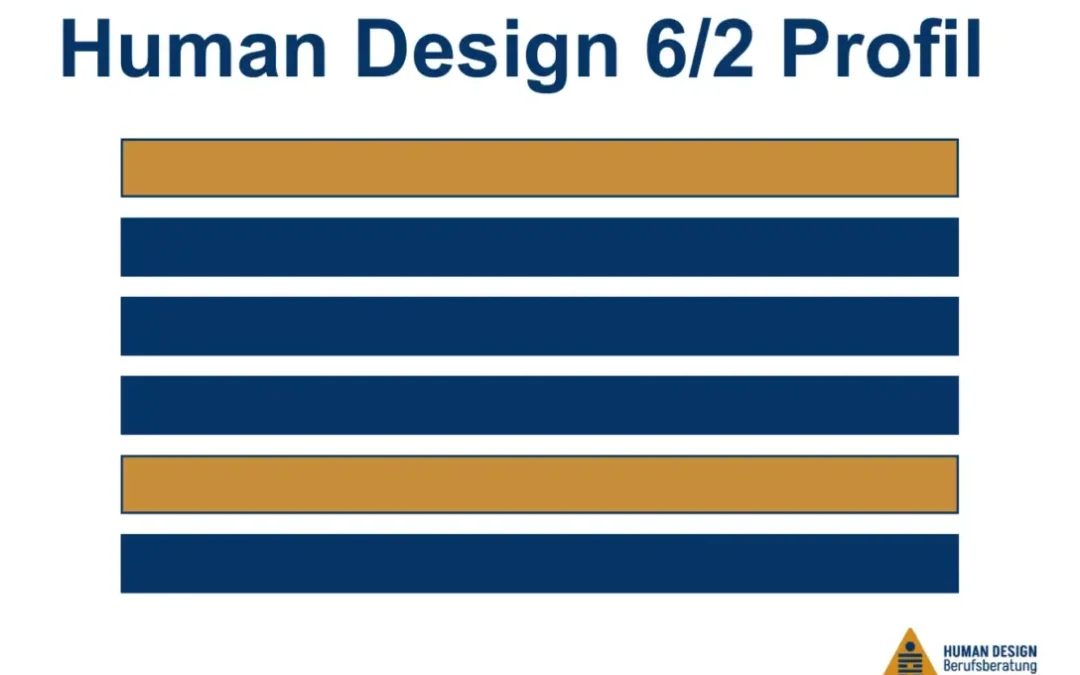Human Design 6/2 Profile in the working world
You have the Human Design 6/2 profile? Then I would like to briefly describe to you how your profile is composed. The profiles in Human Design result from the six lines of the basic structure of a hexagram from the I Ching, the Book of Changes (see figure below). In total, there are 12 combinations of these lines that make up the profile. For you it is the two lines 6 and 2. In your Human Design Chart you will also find your two lines as a number behind the point on your conscious Sun (personality) and your unconscious Sun (design).

Characteristics of the lines
Some interesting character traits can be derived from your profile. You are aware of the properties of the first digit. The characteristics of the second digit are rather unconscious to you, especially if you have not yet reached the second half of life. The Human Design 6/2 profile also has interesting traits that you are sure to recognize in your profession.
In traditional human design, the six lines are assigned the characters shown in the figure. In terms of the profession, interesting conclusions can be drawn from these characteristics. Between the first three lines and the second three lines (looking from the bottom up), there exists a change in the way you learn in life. This is more about learning for life and not about how you learn in school, vocational school or university.
How you discover life
With the first three lines you have a learning style which is related to yourself. It is a self-referential way of learning. So if you have a profile with line 1, 2, or 3, you discover life in a self-referential way with respect to that line. With lines 4, 5, and 6, you have a learning style for life that connects you to those around you. Profiles can be composed of two self-related lines, two environment-related lines, or can be a mix of self-related and environment-related lines.
The Human Design 6/2 Profile
With the Human Design 6/2 profile, you are a role model within the scope of your special talents. Your peers look up to you because you have very special skills that you keep developing to master throughout your life.
With your unconscious second line, you prefer to withdraw so that you can develop your talents. With the conscious sixth line, the older you get, the more you take a bird’s eye view of life – including the world of work.
Until you’re 30, you go your way by trial and error. You have to try out a lot of things, be it in different companies or within one company. That’s how you find out what works for you and what doesn’t. In the process, you don’t make mistakes, but gain experience that is an important part of your life’s wisdom.
After 30, you become an observer. You internalize everything you learned and experienced in the first third of your life and fly higher and higher like a bird. You distance yourself more and more from the details. When you have processed and integrated everything, you have the quality of an economic sage and can help shape the transformation of a company or the entire economy. This happens around the age of 50.
Your personal Human Design
You can find out more about your Human Design 6/2 profile and many more aspects of your Human Design Chart or in your written Human Design Analysis.
FAQ: Questions about Human Design 6/2 Profile
What does the Human Design 6/2 profile say?
As a 6/2 profile, you are a role model with special skills. You unfold talents in retreat. Following the trial-and-error principle, you explore your way to 30. From 30 on, you gain more and more overview. From about 50, you live your mastery and you can use this in your job.
Because the working world needs your uniqueness: Get clarity about your vocation with Human Design now. Click on the button below and order your written Human Design Analysis!
Thomas ist Inhaber der Human Design Berufsberatung und von TW Coaching & Consulting. Er ist Systemischer Coach, Emotionscoach und Human Design Experte. Nach 20 Jahren Berufserfahrung in der Wirtschaft widmet er sich heute in seiner Coaching-Tätigkeit psychologischen und spirituellen Themen rund um die Berufung und Persönlichkeitsentwicklung

